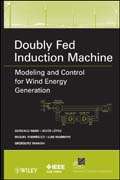
Doubly fed induction machine: modeling and control for wind energy generation applications
Abad, Gonzalo
Lopez, Jesus
Rodríguez, Miguel
This book will be focused on the modeling and control of the DFIM based wind turbines. In the first part of the book, the mathematical description of different basic dynamic models of the DFIM will be carried out. It will be accompanied by a detailed steady-state analysis of the machine. After that, a more sophisticated model of the machine that considers grid disturbances, such as voltage dips and unbalances will be also studied. The second part of the book surveys the most relevant control strategies used for the DFIM when it operates at the wind energy generation application. The control techniques studied, range from standard solutions used by wind turbine manufacturers, to the last developments oriented to improve the behavior of high power wind turbines, as wellas control and hardware based solutions to address different faulty scenariosof the grid. In addition, the standalone DFIM generation system will be also analyzed. ÍNDICE: 1. Introduction to the Wind Energy Generation Systems. 1.1 Introduction. 1.2 Basic concepts of a fixed speed wind turbine (FSWT). 1.3 Variable Speed Wind Turbines (VSWT). 1.4 Wind energy generation system based on DFIM VSWT. 1.5 Grid Code Requirements. 1.6 Voltage dips and LVRT. 1.7 VSWT based on DFIM manufacturers. 1.8 Introduction to the next chapters. 1.9 References. 2. Back-to-Back Power Electronic Converter. 2.1 Introduction. 2.2 Back to Back Converter based on Two Level VSC Topology. 2.3 Multilevel VSC Topologies. 2.4 Control of Grid Side System. 2.5 Summary. 2.6 References. 3. Steady-State of the Doubly Fed Induction Machine. 3.1 Introduction. 3.2 Equivalent Electric Circuitat Steady-State. 3.3 Operation Modes Attending to the Speed and Power Flows. 3.4 Per Unit Transformation. 3.5 Steady-State Curves: Performance Evaluation. 3.6 Design Requirements for the DFIM in Wind Energy Generation Applications. 3.7 Summary. 3.8 References. 4. Dynamic Modeling of the Doubly Fed Induction Machine. 4.1 Introduction. 4.2 Dynamic Modeling of the DFIM. 4.3 Summary. 4.4 References. 5. Testing of the DFIM. 5.1 Introduction. 5.2 Off-line Estimation ofthe DFIM Model Parameters. 5.3 Summary. 5.4 References. 6. Analysis of the DFIM under Voltage Dips. 6.1 Introduction. 6.2 Electromagnetic Force Induced in the Rotor. 6.3 Normal Operation. 6.4 Three-phase Voltage Dips. 6.5 Asymmetrical Voltage Dips. 6.6 Influence of the Rotor Currents. 6.7 DFIM equivalent Modelduring Voltage Dips. 6.8 Summary. 6.9 References. 7. Vector Control Strategies for grid connected DFIM Wind Turbines. 7.1 Introduction. 7.2 Vector Control.7.3 Small Signal Stability of the vector control. 7.4 Vector Control Behaviorunder Unbalance Conditions. 7.5 Vector Control Behavior under Voltage Dips. 7.6 Control Solutions for Grid Disturbances. 7.7 Summary. 7.8 References. 8. Direct Control of the Doubly Fed Induction Machine. 8.1 Introduction. 8.2 DirectTorque Control (DTC) of the Doubly Fed Induction Machine. 8.3 Direct Power Control (DPC) of the Doubly Fed Induction Machine. 8.4 Predictive Direct Torque Control (P-DTC) of the Doubly Fed Induction Machine at Constant Switching Frequency. 8.5 Predictive Direct Power Control (P-DPC) of the Doubly Fed InductionMachine at Constant Switching Frequency. 8.6 Multilevel Converter based Predictive Direct Power and Direct Torque Control, of the Doubly Fed Induction Machine at Constant Switching Frequency. 8.7 Control solutions for grid voltage disturbances, based on direct control techniques. 8.8 Summary. 8.9 References. 9. Hardware solutions for LVRT. 9.1 Introduction. 9.2 Grid Codes Related to LVRT. 9.3 Crowbar. 9.4 Braking Chopper. 9.5 Other Protection Techniques. 9.6 Summary. 9.7 References. 10. Complementary Control Issues: Estimator Structures and Start-up of Grid Connected DFIM. 10.1 Introduction. 10.2 Estimator and Observer Structures. 10.3 Start-up of the Doubly Fed Induction Machine based Wind Turbine. 10.4 Summary. 10. References. 11. Sta
- ISBN: 978-0-470-76865-5
- Editorial: John Wiley & Sons
- Encuadernacion: Cartoné
- Páginas: 704
- Fecha Publicación: 16/09/2011
- Nº Volúmenes: 1
- Idioma: Inglés
